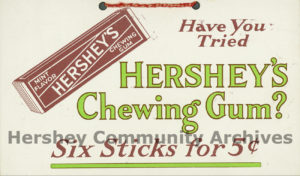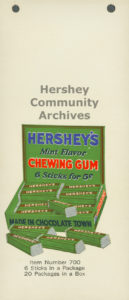Hershey’s Chewing Gum

Introduction
Hershey Chocolate Company manufactured chewing gum between 1915 and 1924. The gum was first introduced under the name “Easy Chew.” Clayton Snavely, Milton Hershey’s cousin and the man put in charge of developing the chewing gum business, was interviewed in 1954 and related the story of how Hershey Chocolate got into the chewing gum business.
About the third week in January 1915, Clayton Snavely spent the weekend with Mr. and Mrs. Hershey at the Dennis Hotel, in Atlantic City, New Jersey. After breakfast Sunday morning the two men took a walk down the boardwalk. There they saw a large Wrigley Gum advertisement.
Mr. Hershey said, “Clayton, Beech Nut Gum has been a phenomenal success. It has gone to their heads, and they think they’re going to put the name Beech Nut on chocolate and put Hershey out of business. Well, there’s only one way to meet fire. It’s to fight it with fire. I’m thinking about doing something in the chewing gum line.”
Learning to make gum
Nothing more was said about it and Snavely headed back to Hershey, Pennsylvania. Three days later Mr. Hershey called him into his office. William Murrie was also there. Murrie had located a man in New York City who owned some chewing gum equipment for sale. Hershey instructed Snavely to travel to New York and purchase the equipment. In addition, Snavely was to learn everything he could about chewing gum manufacture.
Mr. Hershey said, “Clayton, there’s what I want you to do. I want you to go over and buy that equipment in your own name. We don’t want to appear in it in any way. I want you to spend as much time with him as necessary. Get all the information you can, about the formula, the procedure, the making of chewing gum. I want you to find out where you can buy chicle, which is the basic chewing gum. Get all the information you can. Take as much time as you want. And come back with everything you can tell me.”
After picking up expense money from the Hershey Trust Company, Snavely caught the afternoon train to New York. The equipment was purchased for $500 cash in order to hide the Hershey name. He spent several days learning the basics of making chewing gum. The seller also introduced him to the wholesale district and helped him buy the original purchase of chicle.
The machinery, which had been stored in the basement of a cigar factory on West Broadway, was crated and shipped to Hershey and set up on one of the second floors in the chocolate factory. The purchase included:
- 1 mixer and attachments
- 1 set of rolls and attachments
- 1 chicle chopper
- 2 scoring machines
- 36 five-foot drying boards
- 24 small drying boards
- 36 chicle dryers
- 1 marble slab
After Snavely returned home, Milton Hershey met again with him and gave him new instructions. He wanted Snavely to visit the Beech Nut plants in New York that offered visitor tours and glean what information he could from observing and talking with the locals. Snavely left town again to follow Mr. Hershey’s instructions. Once he got back, gum manufacture experiments began.
Naming the product
Joe Snavely, from the printing department, was instructed to print labels for the new product. The question was, what to call the chewing gum? Someone said, ‘Easy Chew.’ It certainly couldn’t be HERSHEY at that stage of the game. So a blue label was designed with a white printed name on it, EASY CHEW, in big letters. They began to make the gum, and it wasn’t bad. On the strength of that, they began to sell the penny product around Hershey. They sold it at the Hershey Department Store; Erb & Son, Hockersville; Frank B. Kendig, Annville; and some other local outlets. Mr. Hershey said, “We’re on the right track; go ahead.” More and larger cooking, sizing, and wrapping machines were bought. Additional help was hired. As the chewing gum production was getting underway, Thomas J. Walton, one of the most experienced men in the chewing gum business, was hired.
Marketing Hershey’s Gum: 6 sticks for a nickel
William Murrie, always the salesman, conceived the idea of packing six sticks for a nickel instead of five, the industry standard. Mr. Hershey thought it was all right. Unfortunately, the gum wrapping equipment was all set up to pack five sticks. “Well,” Mr. Hershey said, “we’ll change it.” Changing it meant a long delay and a complete overhaul of the wrapping equipment.
So it was all set up and Hershey started to market its new product. Orders increased and production leapt to keep up with them. More equipment was added and before long there were twenty-four wrapping machines. About a hundred people were working full time, ten-hour days and a half day on Saturday, a 54 hour week. A brand-new chewing gum label was designed, carrying the Hershey name, similar in design and color as the milk chocolate wrapper.
The initial success of Hershey’s gum business was short lived. Wrigley called the attention of the federal government to the fact that Hershey was selling six sticks of gum in a pack but only paying tax on five sticks. To every twenty pack box, a six-cent war tax stamp had to be affixed. The stamp was applied by special machines. Hershey, with an extra stick in every pack, had one hundred twenty sticks in a box, whereas Wrigley only had a hundred sticks. Wrigley argued that Hershey was not paying his full tax. As a solution, the government slapped an extra four cents on the Hershey box. Hershey was triply penalized: he gave the public the extra stick at the same price of his competitors, he had to pay a four cents tax on each box, and he had to pay for putting on the extra tax stamps by hand, because his present machines could not be adjusted to handle the additional tax.
Production moves to New York City
In 1919 the factory was moved to New York City. Here, in the O’Neil-Adams Building, a six story structure on Sixth Avenue between 21st and 22nd Streets, where they made chocolate coating and some bar goods, they also made chewing gum. Wheat was introduced as an ingredient, in the form of finely ground flour to make the gum more chewy. The flour was ground in the Hershey, Pennsylvania sugar mill and shipped to New York.
Production was raised to five thousand boxes a day. Unfortunately, orders did not match production. The first job John Gallagher had when he came to Hershey in 1920 was to cut down chewing gum production to the size of the orders. Gallagher counseled Milton Hershey to drop the chewing gum line. Herbert Hoover, the new Secretary of Commerce in the Harding administration, put restrictions on the importation of raw materials for the manufacture of non-essential products. In 1921, chewing gum was not yet regarded as essential to national morale. As a result, Hershey could not get sugar or chicle for his chewing gum. Production limped on a few more years before being discontinued in 1924.
